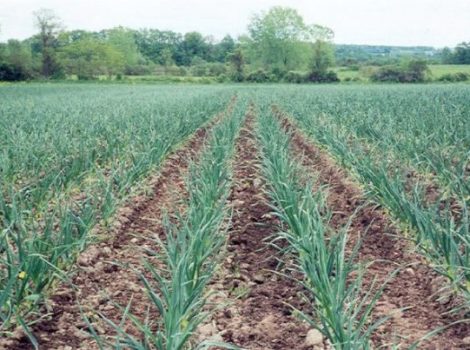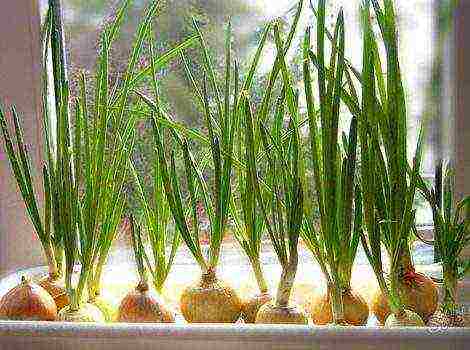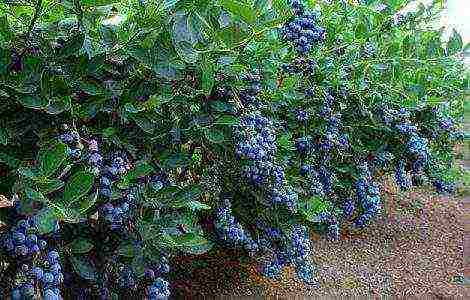Content
- 1 Why bred fish in their summer cottage?
- 2 About fish farming
- 3 Benefits of fish farming on site
- 4 The main patterns of the construction of a reservoir
- 5 Fish species
- 6 Concrete pond
- 7 DIY concrete pond
- 8 Pond without lining
- 9 Ravine pond
- 10 Suitable types of fish for breeding in the pond
- 11 Advantages and disadvantages of fish farming at home
- 12 Types of breeding pools
- 13 How to make a pond with your own hands
Living outside the city is becoming prestigious and comfortable. Potato fields, tomato greenhouses and carrot beds are a thing of the past. People try to make their leisure time more enjoyable and come up with something new. One of the areas of practical and interesting work is fish. At the dacha, it is bred in ponds of different sizes. Making a homemade reservoir for this purpose is not difficult. However, before picking up a shovel, it will not be superfluous to familiarize yourself with the pitfalls of the process.
Why bred fish in their summer cottage?
A pond on a personal plot is created in pursuit of different goals: to complement the landscape design, to provide plants with water or to organize a swimming place. Why not use a pond in the country for fish farming?
The owner of the site may be the unwitting owner of an uncomfortable relief: a ravine, a lowland or a drainage ditch. It is not rational to throw all your strength into eliminating irregularities. It is easier and cheaper to adapt it for keeping fish. Cooking a pond from scratch is a difficult task that requires competent calculations and physical effort. High groundwater helps to feed the self-made lake and makes it possible to exclude waterproofing measures. Such soils are poorly suited for growing gardens, and fish in a dacha in a pond will compensate for this problem.
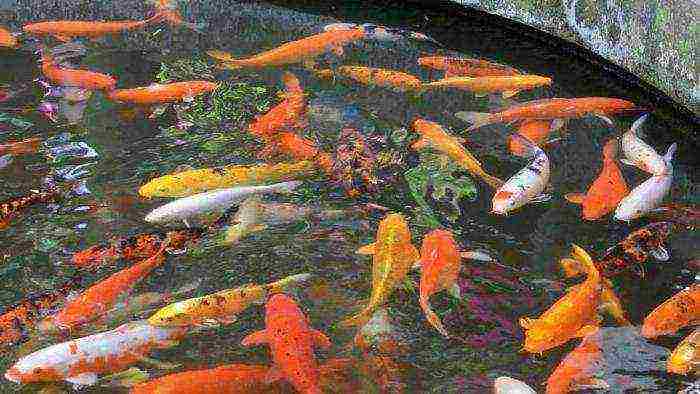
About fish farming
A serious approach to fish farming on the site brings moral and material satisfaction. The productivity of small ponds is much higher than huge ones. A reservoir from 20 to 50 m2 allows you to keep up to 15 species of fish with a weight of up to 150 c / ha.
Fish in the country grows for 1-2 years before reaching the marketable mass. By the end of the first year, the peled weighs 70-120 g. Carp over the same period in a warm reservoir with rare planting reaches 300-350 g. Silver carp also have a fast growth rate. And tench and crucian carp will gain a comparable mass only in three years. For this reason, they begin to grow them from the age of one, buying them in fish nurseries.
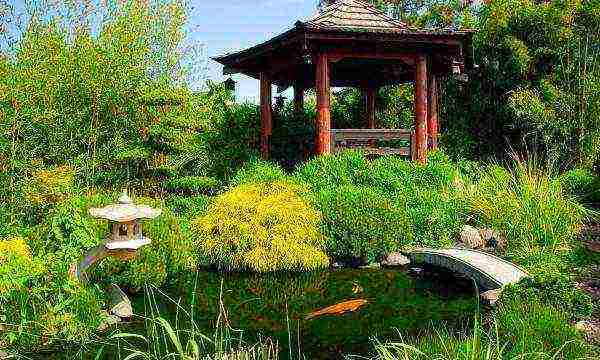
Benefits of fish farming on site
Farming fish on the site is not comparable to industrial production in terms of volumes, methods and conditions of keeping. The reservoirs are, as a rule, multipurpose. Fish in the country is not raised for the purpose of generating huge profits. It serves for beauty, comfort and peace of mind for the owners of the site.
This is also a sign of well-being, it allows you to stand out from others. Not everyone has a pond with live fish at their summer cottage. The advantage of this solution also lies in the fact that the quality of the water is under control, pesticides and industrial wastewater will not get into it. The fish pond at the dacha is a source of healthy and natural food for the family.
For the objectivity of the description, it is worth mentioning that breeding fish in your own reservoir requires some effort. The owner will need knowledge of fish farming, attentiveness, endurance and love for nature.
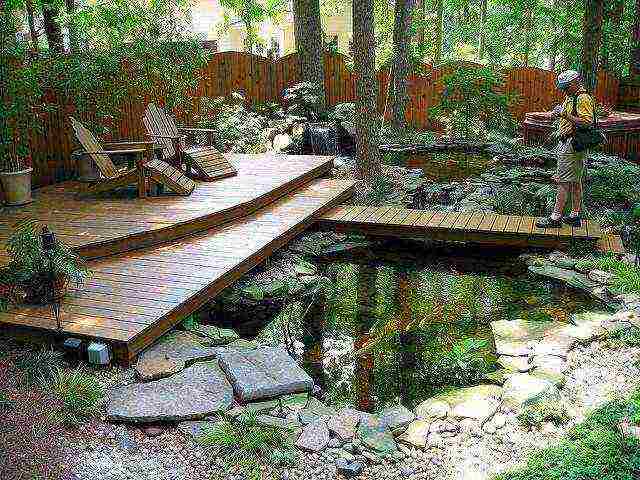
The main patterns of the construction of a reservoir
How to make a lake in the country for fish on your own? You should start by studying the basic rules regarding this structure:
- Water bodies of a small area require more attention, because they do not form a natural biocenosis. They look like a big puddle. A huge pond will not be affordable for many. In addition, not at every site a suitable site can be allocated for it. The golden mean between these options ranges from 25 to 50 m2.
- It is worth carefully choosing a place for a future reservoir. A prerequisite is the presence of shaded and illuminated areas of the water surface. A low-lying pond will be flooded by rain and melt water.
- A special relief is created at the bottom of the pond, combining areas with different layers of water. They are arranged in steps, separated by ledges.
- Choose a soil based on the type of fish. Carps require hard rocks (pebbles, coarse sand, crumbled granite).
- Small fish, no more than 15 cm long, need 50 liters of water. The volume of the pond and the number of individuals are calculated based on this rate.
- An important addition that the pond needs: do-it-yourself fish farming in the country is impossible without installing a filter pump. With the help of it, the water is cleared of secretions and its flowering is prevented.
- If the fish will be in the reservoir all year round, then it needs a wintering well. It can be organized using a large container, which is buried in the center.
Fish species
The fish is chosen based on the goals facing the owner. And also from the existing pond and other conditions. Ornamental fish are widespread: gold and koi. Growing fish in the country of such species is carried out in small ponds. They stick to the surface and take food from their hands.
For economic purposes, carp, crucian carp and tench, which live in the depths, are bred. The list of species used for keeping in ponds is significant: silver carp, grass carp, perch, carp, trout, etc.
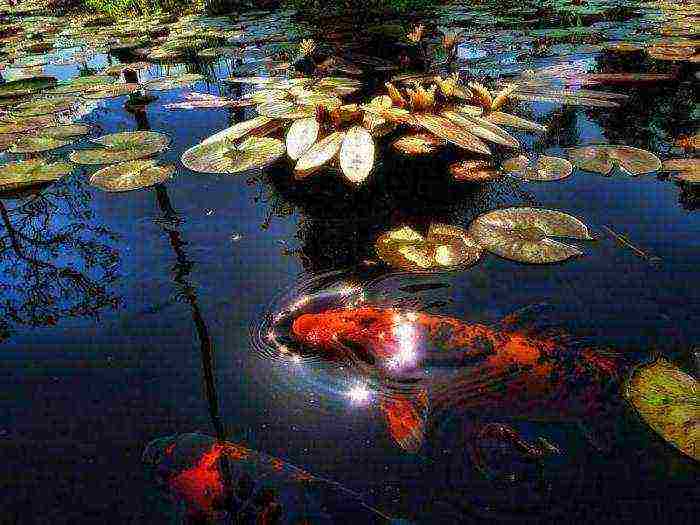
Concrete pond
The shape of a pond with a concrete base can be arbitrary. The most optimal options are rounded, for example, oval or pear-shaped. The bottom of the future reservoir is poured with concrete over a prepared pillow. The strength and durability of the structure will be added by wire reinforcement. A mesh with a mesh side of 15 cm is laid out of it. Before concreting, a reinforced concrete pipe is installed, which will serve as a winter house for fish. Its lower end is buried below the winter water level in the ground.
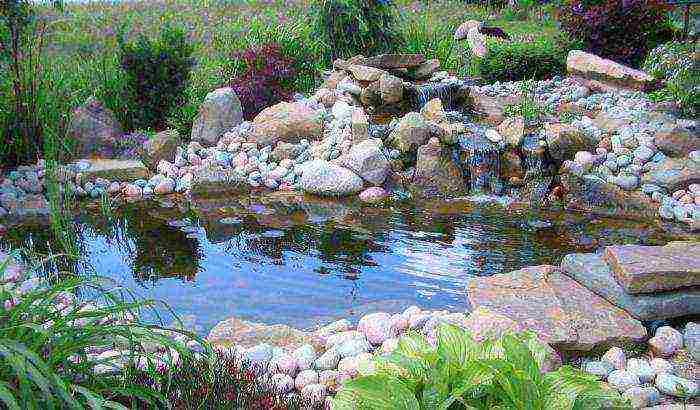
DIY concrete pond
Live fish in the country needs a cozy home. Stages of making a pond with a concrete base:
- The soil is selected according to the drawn sketch. Terraces and recesses are being made. The surface is cleared of protruding roots and debris. Areas for aquatic vegetation are being prepared. A grid of reinforcing bars is laid over the entire surface. They are fastened together with a knitting wire. The metal skeleton will be embedded in the concrete.
- Cement M400, coarse sand and crushed stone are mixed in a ratio of 1: 2: 3. The bottom is poured with the resulting mixture and carefully tamped to prevent the appearance of voids. They are waiting for it to set and formwork for the walls is installed. The side surfaces of the pond should not be vertical, and their thickness should be less than 12 cm.
- Whenever possible, waterproofing is done. A couple of layers of roofing material are placed on the concrete layer, which has begun to set, and poured with a solution. In hot weather, the surface is protected from premature drying out with raw material, sawdust or hay.
- The pond for fish in the country is almost ready. A hose is brought to it, hiding it among the stones to make it natural. Fill with clean water.
- A pipe is mounted on one of the banks, which will serve as protection against overflow. Through it, excess water will be removed from the reservoir.
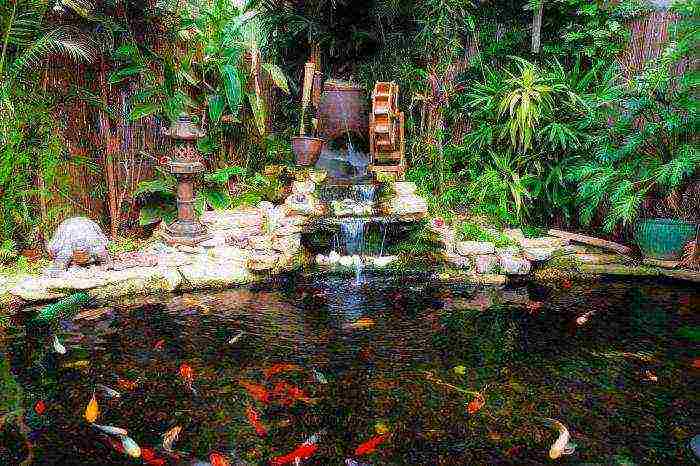
Pond without lining
If the groundwater on the site is located close to the surface and soil, then a pond can be made without concreting.Ditches are created, the walls of which are covered with a layer of clay or plastic wrap. Such a solution is easy to build, but requires regular monitoring and supportive measures. A trench dug in sandy soil must be coated with a layer of clay at least 10 cm thick. Turf or straw is placed on top.
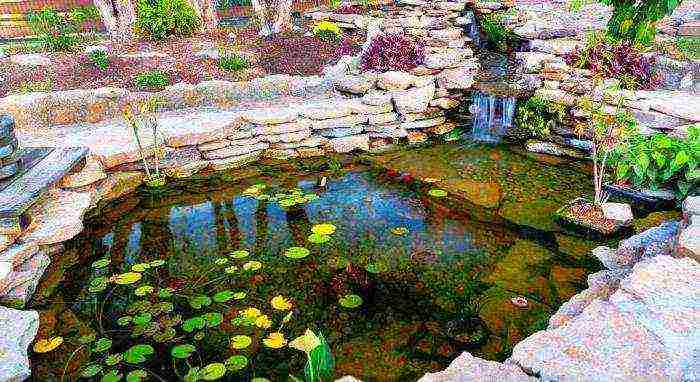
Ravine pond
How to make a fish pond in the country without large investments? Do it yourself from a small natural ravine. To do this, it is corrected and improved. They act approximately according to the following scheme:
- The natural depression is increased in size.
- They create a dam from the earth. For this, the soil is poured in thin layers (up to 20 cm) and tamped. Moisturizing from a watering can improves the quality of work. The height of the partition is created 50 cm above the expected water level.
- They will organize a groove through which the flood waters can pass without destroying the dam. The bypass channel is located bypassing the earthen partition.
- In the ditches through which water flows in and out, concrete gutters are sometimes placed. The bottom and sloping parts of the pond, if desired, are reinforced with a metal mesh, stones, turf, etc. The dam is made wide and covered with a layer of sand.
- The filled pond is kept empty for 1-2 months. During this time, a muddy deposit forms in it, and the plants will take root. After this period, the reservoir is emptied and clean water is poured. Only now can fish be allowed into the pond.
Equipping your own pond at a summer cottage is not an easy task. The information provided will help the owners to better orient themselves in this matter and avoid many mistakes. Correct organization of feeding and keeping fish is the key to success.
Better than your own pond in the country can only be your own stocked pond in the country! Fishing at any convenient time and in any weather, well-fed and ecological fish caught - what could be better for an avid fisherman?
But by itself nothing will come from nowhere, you need to put your hands, strength and time, as well as some knowledge to everything. Any business has its own tricks, let's try to share them with you! In this very informative publication, we decided to tell you about how to breed fish in a pond on a site. Therefore, if you pay attention to these tips, then you will definitely succeed.
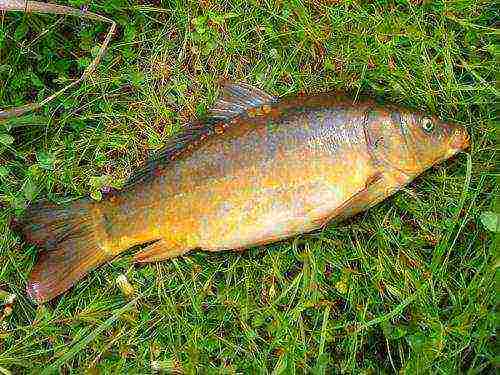
The correct dimensions of the fish pond
Of course, first of all, you may need a home pond for fish farming. Therefore, you first need to decide on its location. The best option would be a low, semi-shaded area. It is not worth planting trees on purpose, their roots can deform the reservoir, and the leaves, attacking and starting to rot, spoil it in the end.
Now about the dimensions. The depth is required at least one meter, but ideally it all depends on the species of fish that are planned for breeding in it. Better small. but deeper than the wide and shallow version, the second will absorb too much oxygen, and in fact it is necessary for fish to breathe.
In winter, to provide fish with oxygen, it will be convenient to freeze a bundle of straw right in it; oxygen will perfectly reach the depths of the pond through its hollow tubes. Small holes drilled into the ice will also enrich the water with oxygen.
Also, take into account not only the size of the fish, but also their number, so that they do not get cramped in a small pond, because one fish 10 cm long needs 50 liters of water. A large amount of food, some of which is likely to remain undetected, can contribute to water deterioration.
In a deep body of water, it is easier for a fish to winter without fear of freezing through. BUT! On hot summer days, the layers of water will warm up unevenly, which will slow down the reproduction of microorganisms that are also needed as food for fish. Consider also the net area of the water surface without vegetation, and the method of filtering the water.
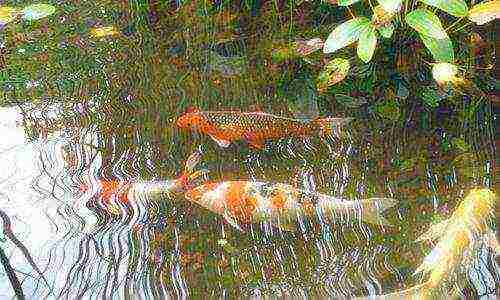
Popular fish breeds for an artificial reservoir
It is also worth talking here about what kind of fish is best to breed in a small pond.Carp and crucian carp are the leaders in popularity for breeding in artificial ponds. Further behind them are lines, goldfish and cold water trout.
Carp will not be cramped at all in small ponds, oddly enough, it grows fat there even better. In a small space, you will not roam much, but they feed regularly and well. This promotes active weight gain. This is an unpretentious and omnivorous fish, especially the sun with slightly alkaline water. Then she will grow rapidly and mature to puberty by the fourth year of life.
So, for carp you need a reservoir from one and a half meters deep, four meters long, and six meters wide. There are no more than twenty individuals per cube of water. Then an excellent bite of fatty carps will be provided to you!
Now about the carp. For them, simply grace is stagnant water with an abundance of different vegetation. The dimensions of the reservoir favorable for them coincide with the dimensions for the carp, so it will be easy to keep them in one pond. In this case, do not forget to take care of the holes in the ice in winter to supply oxygen to so many fish.
But tench cannot stand crucian carp. And in a shallow pond he will fight carps for food. Although they are also an unpretentious and omnivorous breed.
Goldfish, despite their noble name, are actually unpretentious to both food and living conditions. From just one pair of these individuals, the pond will be populated by many goldfish very, very quickly. Imagine a pond teeming with shiny goldfish. You will simply run out of desires, but you will not run out of fish!
Japanese koi carps are just as shiny, and the color of the offspring by the parents cannot be predicted. Another voracious breed. Therefore, they respect spacious and deep reservoirs, the muddy bottom of which can be searched for a long time, looking for food. By the way, they also eat small fish.
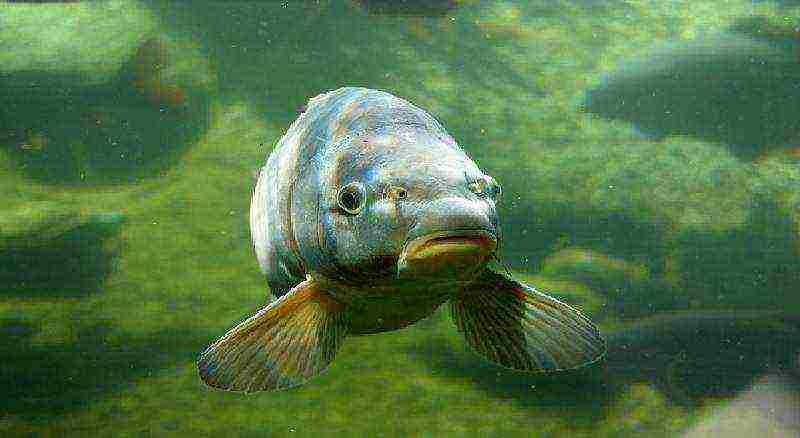
So, let's get down to building a pond
Here we are talking about how to breed fish in your home pond. But first you need to build the pond itself. After you have decided on the desired dimensions, we proceed to digging the foundation pit. Its bottom must be properly tamped. Then it is advisable to cement it and close it with plastic wrap on top. With careful use, it will last for several years. If this is an expensive option for your wallet, then just cover the bottom of the future pond with a film. And also, as a budget option, consider leaving a lot of unusable tires glued together at the bottom.
If the funds allow you, you can buy special coconut or synthetic mats. Algae grows very quickly on their surface and the coastal edge will be reliably masked.
Now that the pit is complete and processed, you can fill it with water. And not immediately to the brim, but first by one third, and better with well or spring water. And the film, with such a gradual filling, will have time to level out. We pour a layer of river sand at the bottom, where we plant various algae. And now we add water to the end.
In conclusion, we are engaged in landscaping the coast. Add cattails, reeds and willow to the pond landscape. If the reservoir was also planned for breeding crayfish, then it is simply necessary at its bottom to have stones, broken pots and so on as shelters for them.
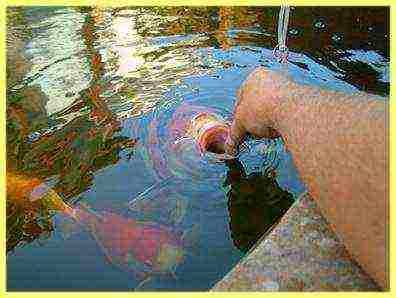
Your pond microclimate
So, the water is flooded. But in no case should you immediately launch fish there! First you need to let it settle and warm up. You can pour a bucket of water from a natural reservoir to populate the microflora.
A neutral environment with an acidity level of 7-8 ph is considered the best condition. If the acidity drops to 5, then you urgently need to acidify the water with soda or limestone. Therefore, do not forget about acidity measurements in different places of the pond, because it depends on the speed of interaction of substances with the sun.
And before the fish are released into the pond, it is necessary to balance the temperatures in the pond, and in the container, where the fish were kept all the time, in order to exclude for them a temperature shock, which even adults can not bear.
Best fish food
You were able to find out what kind of fish to breed in the pond in the country. Now it is worth figuring out what food to use in order for your fish to eat and grow well in the pond. For carp and tench, this is not a matter of principle, they will gratefully absorb everything that the owner gave them. Usually they are fed a simple compound feed for birds or pigs. If it is presented as a powder, then it will need to be mixed with pond water to form a porridge.
The rest of the fish respect a mixture of cereals and legumes. It needs to be scalded before feeding for better swelling. Well, no fish will ever deny itself the pleasure of eating earthworms or some kind of insects. In terms of quantity, the feed may exceed the weight of the fish, but not more than by 6 percent.
Usually fish are fed twice a day, always in the same place. A shallow place is best for this, where you can put a tray of treats directly into the water, and then remove it. This will eliminate possible food residues in the water, which will quickly spoil the water.
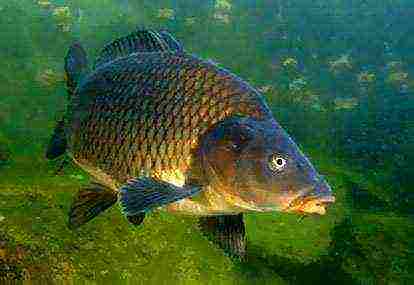
Summing up
Now you know how to breed fish in a dug pond. Who's to say that fish can't be trained? Try to feed them in one place at the same time and see what happens! And if you also accustom them to the sound of a bell before feeding, then your fish will look like obedient students who are going to a lesson with a bell.
Such a pond can be used not only for your own pleasure, but also as a source of income. After all, you can not only sell the surplus of farmed fish, but also rent the pond for fishing on an hourly basis. Or maybe you can think of something else!
An artificial reservoir in a private area can become a source of not only aesthetic, but also gastronomic pleasure. With some effort in fish farming, you can get a good help in providing yourself and your loved ones with valuable fresh product. And if you get down to business on a grand scale, then you can make money. After all, doing everything with your own hands in the country at home is not so difficult.
Suitable types of fish for breeding in the pond
The fish species are selected according to the breeding conditions. The determining factors are air temperature and water composition. The type of pond is essential - flowing or standing. When selecting varieties, one should take into account the coexistence of breeds, competition for food. The most unpretentious and productive are:
- Carp or carp - thermophilic, but resistant to temperature fluctuations. The diet is plant food and compound feed. It enters puberty at 1-3 years of age, depending on the ambient temperature. The varieties are scaly, mirror-like and leathery.
- White amur - a large relative of the carp. Reaches a weight of 50 kg and more. Homeland - the Far East. It eats a large amount of plant food, is used to clean up overgrown reservoirs.
- Black cupid - similar to white, but feeds on shellfish. The scales are dark in color. Well sanitizes ponds from pests of other species.
- Silver carp - very similar up to 3 years of age. Then spots on the scales appear in the motley one. Reach 50 kg. Silver carp eats only plants. Motley is more unpretentious.
- Buffalo - similar to carp, homeland America. In terms of growing conditions, it is similar to carp, but meat is much more valuable in taste.
- Channel catfish - omnivorous, large, thermophilic. Homeland America. When properly fed, it has a very pleasant meat flavor.
Less productive, but well amenable to cultivation in a man-made pond, are:
Gold and goldfish are unpretentious, fast-growing. Can interbreed with other fish species. Gains weight up to 5 kg.Feels good even with unfavorable water composition.
Trout, pike, tench, sturgeon are also bred in artificial reservoirs.
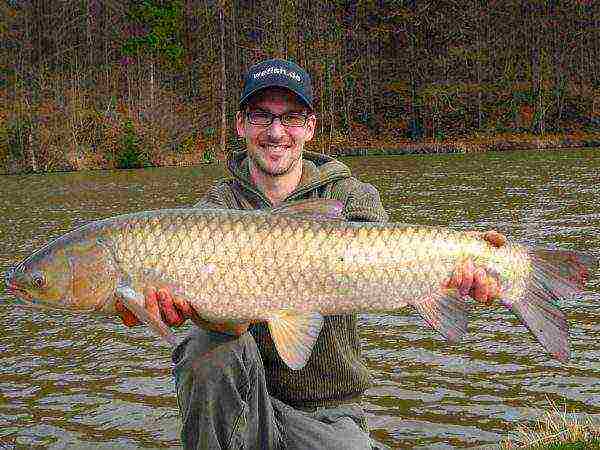 The grass carp is a type of freshwater fish suitable for breeding in a pond
The grass carp is a type of freshwater fish suitable for breeding in a pond
Advantages and disadvantages of fish farming at home
An important advantage of cultivation in a home garden is the ability to receive for personal consumption or sell all year round products that are in great demand.
Fish meat contains a lot of valuable substances and vitamins. Fresh catch has excellent taste.
The investment required to start fish farming is not very large. The labor intensity of cultivation is from 3 to 5 hours a day. Weather conditions when using an artificial reservoir insignificantly affect the growth of individuals.
The main investments take place at the initial stage. You need to build a pool or dig a pond.
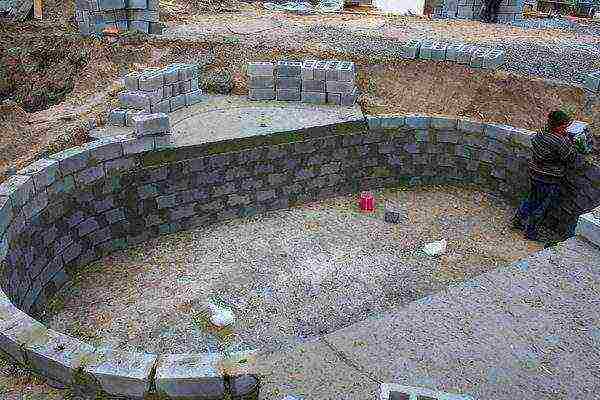 The main expenses for breeding - at the initial stage in the manufacture of a pond
The main expenses for breeding - at the initial stage in the manufacture of a pond
Their type and size are determined by the financial capabilities of the owner and the area of the site. The minimum depth of an artificial reservoir is 1-1.5 m. The volume is calculated from the estimated number of individuals inhabited in the pond. One fish 10-15 cm long should have at least 50 liters of water, i.e. in one cubic meter no more than 20 specimens can coexist peacefully.
The recommended area of the water surface is 25-50 sq.m. Usually 1.5-2 years are enough for a fish to gain weight.
Types of breeding pools
The quality of water in a mini pond, its chemical composition depends on the source of the pond filling. It also determines the temperature, the availability of food and the oxygen supply of the aquatic environment.
What type of filling is there:
- Stream or river. Water enters the reservoir from natural sources through the supply channel. The excess is removed by a branch duct. The content of oxygen and plankton in a pond with such filling is favorable for breeding, because closest to natural conditions.
- Rodnikovoye. Clean water with a high oxygen content is most favorable for breeding fish of different species. For the source of food in the territory adjacent to the reservoir, daphnia pits are arranged - shallow small depressions for the reproduction of plankton. They communicate with the main body of water. Daphnia move to the pond and serve as food for fish.
- Atmospheric. In the absence of rivers, streams and springs, the source of moisture is rain and melt water. Well-heated water is favorable for the development of vegetation and living organisms.
- Closed water supply. The use of ponds without external water sources became possible thanks to the use of special equipment: pumps, filters, ultraviolet sterilizers, etc. When constructing a reservoir, special attention should be paid to waterproofing the bottom.
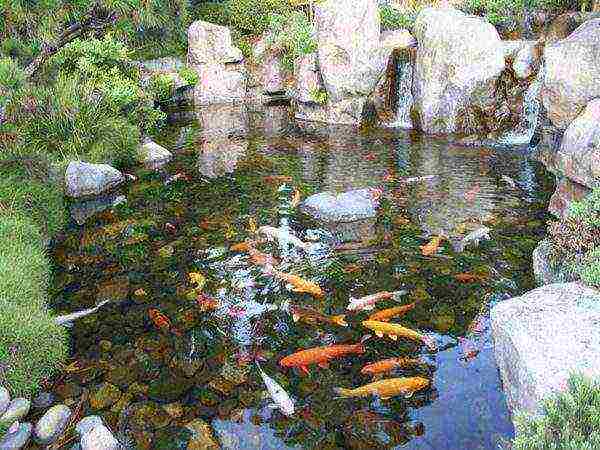 Fish pond with stream filling
Fish pond with stream filling
How to make a pond with your own hands
Having decided to arrange a fish pond on the site, you need to determine its location, area and method of construction. If there are no natural sources of filling, the reservoir is built using a closed water supply.
How to choose the right site
The place for the pond must meet the conditions:
- stay away from noisy places and highways,
- be shaded by trees, but not under them, because falling leaves pollute the water,
- do not be located in the lowlands, because there is a risk of contamination by running off rainwater,
- have a source of electricity for equipment with water purification filters and oxygen enrichment plants.
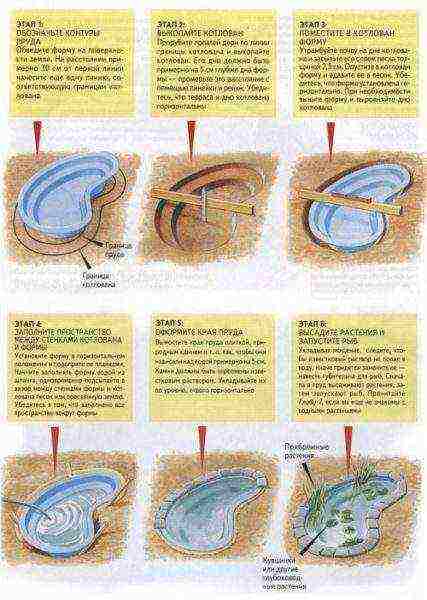 The scheme of making a fish breeding pool
The scheme of making a fish breeding pool
Required tools and materials
The most durable is a pond with a concrete bottom. Its device requires significant material and labor costs, which will pay off with interest in the process of long-term operation.
To build a pond you will need:
- rubble,
- sand,
- cement,
- mesh of reinforcement with a diameter of 3-4 mm and a cell of 30x30 cm,
- formwork from boards,
- roofing felt or other material for waterproofing the bottom and walls,
- pipes for inlet and outlet openings,
- waterproofing additive for bottom and wall plaster.
The technology of creating an artificial reservoir in the country
- Mark the size of the pond on the ground. For this, pegs and a cord are used. For fish farming, the shape of the pond does not matter.
- Digging a pit manually or with an excavator. The optimum depth is 1.5-1.8 m, the angles of inclination of the walls are 20 °.
- Before concreting, prepare from sand and crushed stone with compaction of the bottom.
- Laying waterproofing from roofing material or film with its output to the surface of the earth.
- The first layer of concrete is poured onto the bottom with a thickness of 10 cm, the reinforcing mesh is tamped and recessed along the entire bottom.
- The second layer of concrete is poured.
- Install the formwork for the pond walls. When finished, they should be 10-12 cm thick.
- The walls of the reservoir are reinforced and poured with concrete.
- Concrete surfaces are covered with plaster with a waterproofing additive or liquid glass. The material for processing the walls must be safe for the life of fish.
- The necessary equipment is installed: pumps, filters, oxygen water enrichers.
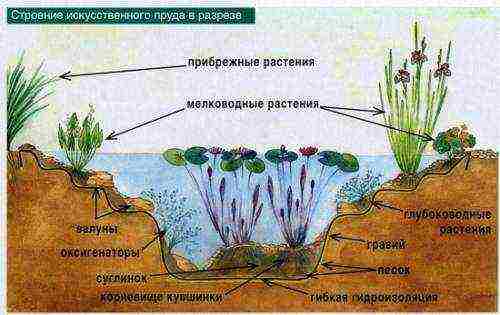 Schematic structure of a fish pond
Schematic structure of a fish pond
For a safe wintering of fish, a wintering well should be provided. It is arranged from asbestos-cement pipes with a diameter of 80 cm or ordinary reinforced concrete rings. In a well deepened to the level of 2.7 m, covered with a wooden shield, the fish will not freeze or die from lack of oxygen.
Even a beginner can build a pond with his own hands. Fish farming will not take much time if the process of stocking, fattening and catching is well established. Even if the purpose of fish farming is not to generate income, this activity will be beneficial and enjoyable.
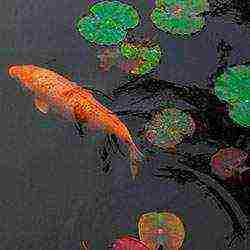 What could be better than your own summer cottage. Indeed, in this case, you can implement a large number of ideas. One of these is the creation of a small reservoir in which you can spend your leisure time fishing and even fishing. Further, what kind of breed is better to breed in a small pond near the dacha.
What could be better than your own summer cottage. Indeed, in this case, you can implement a large number of ideas. One of these is the creation of a small reservoir in which you can spend your leisure time fishing and even fishing. Further, what kind of breed is better to breed in a small pond near the dacha.
The best fish species for a small pond
To understand which breeds are best suited for a not very large reservoir, you should have an idea of the most popular types of freshwater inhabitants:
- Carp. Ideal for a compact pond: it is completely unpretentious in food and living conditions. At the same time, it is distinguished by excellent taste and nutritional value. Carp is thermophilic and the decision to breed fish like this should be made only when living in a sufficiently warm climate: the optimal temperature for a comfortable life for carp is 18-30 degrees Celsius. The period of onset of puberty directly depends on the mildness of the climate: in a warm climate, already in the 2-3rd year of life, carp are ready for mating, in a cold one - in the 4th-5th year. Carp grows rapidly and reaches a weight of 1 kg by the age of three.
- Golden crucian carp. A small beardless fish with a copper belly. The best option for raising fish in a small stagnant body of water. Crucian carp is unpretentious, it takes root well in water with high acidity or with insufficient oxygen. The sexual maturity of crucian carp occurs at 2-4 years. The advantages of golden carp include its vitality and excellent survival after crossing with other fish.
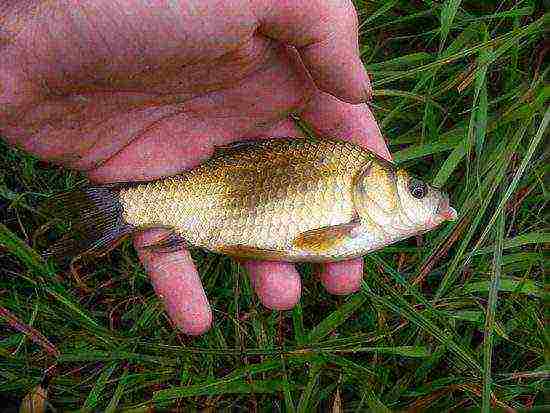
Golden crucian carp
- Black cupid. Under high-quality conditions, the weight can reach 50 kg. Sexual maturity occurs at the age of 7-10 years. The black carp gets along well with other fish. In addition, he is considered a water sanitary officer, as he feeds on molluscs, which are often carriers of parasites.
- White and variegated silver carp. A large-headed fast-growing breed that, with a high quality of life, can reach 50 kg of weight. Silver carp eats exclusively natural food.The silver carp actively eats animal plankton, so it cannot be grown together with carp due to the high competition.
- Sturgeon. A very profitable breed from all sides, with high-quality maintenance it grows up to 4 kg already in the second year of life. The most popular representatives of the family, suitable for growing in a small reservoir, are: Lena sturgeon (outwardly similar to sterlet, but different from it in large size), paddlefish (very large fish that is suitable for reservoirs with a temperature of about 20-25 degrees).
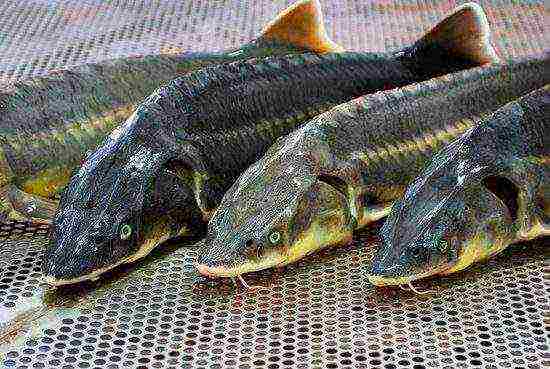
Lensky sturgeon
- Peled. It grows quickly, it is distinguished by its unpretentiousness to the conditions of keeping and feeding. Feels great in cool water. It is considered a good alternative to trout, while, unlike the latter, peled is not so demanding on the composition of water and the oxygen content in it.
- Tench. An unusual fish that changes color immediately after being caught: its golden skin is covered with dark spots. This is due to the large amount of mucus that freezes in the air. A good place to breed fish would be a calm, small body of water with lots of vegetation.
- Catfish. Perfect for a small pond. Catfish is carnivorous, large in size, very hardy. In winter, it hibernates. Friendly to other freshwater fish.
Attention! It is advisable to isolate sick fish as quickly as possible from the rest of the living creatures in the pond. It is very simple to calculate such an individual: it floats on its side along a circular trajectory, rubs against various objects, a white bloom can be seen on the fins and eyes of sick animals.
The intricacies of fish farming in a small pond
In order to fully enjoy the fishing process without leaving your own summer cottage, you need to make sure that the pond near the house is created using a certain technology:
- The depth of the pit for the pond should be at least 1.2 m. Otherwise, it is highly likely that in winter the pond will freeze and all the fish will die in it. Also, do not forget about the need to arrange ice holes in the reservoir, otherwise the living creatures may suffocate when it is completely covered with ice.
- The size of the pond will directly depend on the amount of fish you would like to place in the pond. So, for example, for one fish about 10 cm long, about 50 liters of water will be needed. To determine the optimal amount for a pond, it is necessary to divide the volume of the pond pit by the amount of water for one fish.
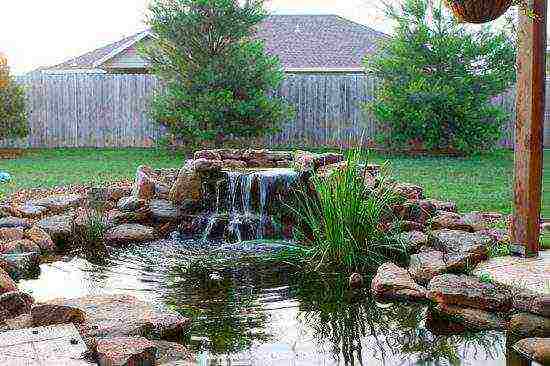
- The material of the bottom and walls of the future fishing site must be absolutely safe for the fish living in it. The bottom of the reservoir must be laid out with a layer of gravel and sand, and also add plants that will serve as an additional source of food for the pond abodes.
- Regulation of the number of fish. This process must be carried out without fail. This can be done very simply - to catch some of the "inhabitants" of the reservoir. Actually, for these purposes it is customary to breed fish in a pond.
- Correct feeding. The optimal period for feeding is spring and summer. At this time, the inhabitants of the reservoir live and grow most actively. After each feeding (after about 10-15 minutes), food residues must be collected from the surface of the water so that it does not rot there.
Advice. It is undesirable to place fish caught from the river in a painstakingly created reservoir, as it may be sick. It is better to purchase all the necessary types of living creatures in a specialized store.
That's all the subtleties you need to know in order to understand what kind of fish to breed in a small pond. Happy fishing!
How to breed crucian carp: video
